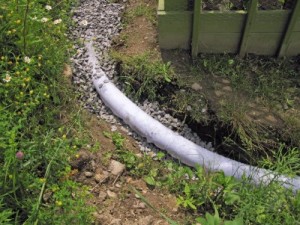Au Revoir Water
 Water always flows downhill, and by the easiest route possible. That is the basic concept behind a French drain, a slightly sloped trench filled with round gravel and a pipe that diverts water away from your house. The name actually is derived from the name of a judge, Henry French, who promoted the idea in a 1859 about farm drainage. French drains provide an easy channel for water to flow through. Water runs into a gravel-filled trench, then into perforated pipe at the bottom of the trench. Water travels freely through the pipe, which empties a safe distance from the house. The trench bottom should be sloped about 1 inch for every 8 feet in the direction you want water to flow. Depending on your situation, the water can be diverted to a low-lying area of your property, a drainage ditch, a dry well, or the street. When does a home owner need a French drain? You should probably consider installing one when you have a problem with surface water or a soggy lawn or if you have a basement and water is getting into it. Often French drains are installed when building a retaining wall on a hillside.
Water always flows downhill, and by the easiest route possible. That is the basic concept behind a French drain, a slightly sloped trench filled with round gravel and a pipe that diverts water away from your house. The name actually is derived from the name of a judge, Henry French, who promoted the idea in a 1859 about farm drainage. French drains provide an easy channel for water to flow through. Water runs into a gravel-filled trench, then into perforated pipe at the bottom of the trench. Water travels freely through the pipe, which empties a safe distance from the house. The trench bottom should be sloped about 1 inch for every 8 feet in the direction you want water to flow. Depending on your situation, the water can be diverted to a low-lying area of your property, a drainage ditch, a dry well, or the street. When does a home owner need a French drain? You should probably consider installing one when you have a problem with surface water or a soggy lawn or if you have a basement and water is getting into it. Often French drains are installed when building a retaining wall on a hillside.
If you have surface water, you will need a French drain that extends horizontally across your property, directly uphill of the area you want to dry out. It intercepts water and channels it around the soggy spot. This type of drain does not have to be very deep — a common size is 2 feet deep and 1.5 feet across. If your basement is getting water in it, you will want to install a French drain which is sometimes called a footing drain. It runs around the perimeter of the house at the footing level and intercepts water before it can enter your basement. Sometimes it requires ripping out existing landscaping for proper installation. If you are building a retaining wall on a hillside, you will add a French drain behind the first course of blocks. Otherwise, water moving down the hill will build up behind the wall and compromise it.
A French drain, when properly designed, will create a drainage system that diverts water away from your house and alleviate problems with surface water and soggy lawns. Water damage can be devastating to the structure of a home. French drains provide solutions for drainage issues that otherwise would be costly in the long run.
“French Drain Design: What You Need to Know.” www.HouseLogic.com Web. 09 July 2013.
Call us today to view our new home plans: 713-539-0048 – Sign up for our New Home Buying Tips
Visit our website: https://fairmontcustomhomes.com/
View Our Communities – View our available new home floor plans – View our photo gallery
Follow Us: Facebook – Twitter – YouTube – LinkedIn – Google Plus


Sorry, the comment form is closed at this time.